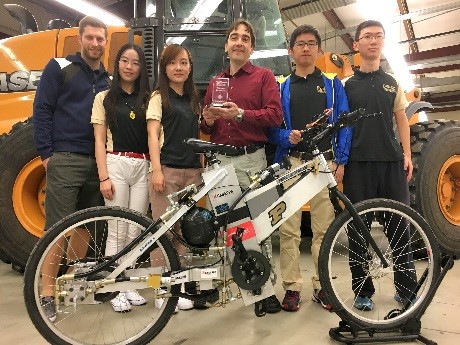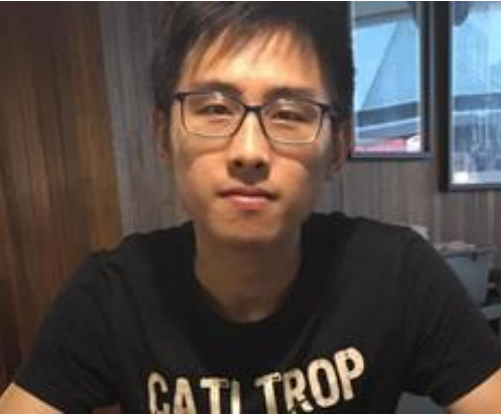Connect Students with Real-Life Experience: The PurdueTracer

The National Fluid Power Challenge is a series of math and science competitions designed to connect today’s students to tomorrow’s fluid power careers. Students’ team are challenged on of the three following topics Action, Robotics, Vehicle.
In 2017, a team of students, advised by Andrea Vacca – PhD, Associate Professor – from Purdue University competed and won the challenge by building an energy-efficient human-powered hydraulic bicycle named the PurdueTracer. We decided to contact the team members (*see the biographies at the end of the article) to find out more about their thrilling experience.
What was the main characteristics of the PurdueTracer?

Gianluca Marinaro. – Our idea was to satisfy biker’s need for different riding occasions, and this has been able by developing an open-circuit hydraulic hybrid transmission allowing our bicycle to operate in four modes: pedaling, charging, boost, and regeneration.
Zhuangying Xu. – Another aspect of our project was to make the vehicle intelligent for the users. We developed an application which enables them to wirelessly know the operation conditions of the vehicle and simply swap controls for bike mode change and gear adjustments using the touchscreen. Additional functions including geolocation, weather and recommendation systems are integrated for better user experience.
The transition from theory to practice should be an exciting experience, can you tell us more about it?
G.M. – I started using Simcenter Amesim** at my university in Naples where I followed the Fluid Power course of the Pr. Adolfo Senatore (also my advisor for the master’s degree thesis). Then during my period at Purdue University, I attended Pr. Andrea Vacca’s lectures, where I learned other skills on Amesim.
During the project, we mainly focused on the components selection, the hydraulic layout, its sizing by creating a model of the bicycle, and the numerical optimization, with the support from Zhengpu Chen our team-member. Meanwhile, we worked also on the mechanical part (sizing and manufacturing) with Yizhou Mao, a PurdueTracer team-member as well.
In terms of technical results we published afterward a technical paper which fully describes the design approach and the main results of the PurdueTracer.
Do you think using simulation has been an advantage for you during the competition to get the 1st rank as Overall Champion?
G.M. – In my opinion, Simcenter Amesim is a very intuitive software, with a very supportive help. The main advantage is the possibility to optimize the whole hydraulic system; other teams of the competition made the sizing manually. In our case, the tool gave us the possibility to predict the bike working in a wide range of working conditions during the design phase by implementing as input the pump’s efficiencies maps. This made the difference. Our model is able to give us fundamental information to make a very satisfying sizing, that predicted the performance of the vehicle in a very surprising way (see section 6 of the paper) and in a wide working range.
Z.X. – Simcenter Amesim is a very useful software for academic development. I did not use the software in person, but for our team using it help a lot for the system design and the refinement. The components are comprehensive, which allows us to build the model and perform design iterations easily. By setting the knowns and the outputs, the specifications of many components were set, which helped us to find the suitable components. Also, with the simulation, as mentioned by Gianluca we can know in advance the performance of the bike, and then compare them to the record of vehicles in previous FPVC competitions. So we can know where our strengths are and where we need to brainstorm to iterate out better ideas. Overall Simcenter Amesim indeed helps in our competition.
Yizhou Mao. – I did not use Simcenter Amesim much for this project since I am more on the mechanical side. Nevertheless, I have to admit that Simcenter Amesim is really helpful. I first knew this software in a hydraulic system course taught by Dr. Vacca. I think Simcenter Amesim is pretty user-friendly, I learned pretty fast and did some simple simulations for the project. And with some basic knowledge, I was able to know what is going on with my teammates’ designs. I would agree that Simcenter Amesim did make a difference to our project.
It seemed like a rewarding experience for all team members, how useful this project has been in your job search?

Z.X. – My future work is the software engineering in Microsoft, mainly focus on Cloud Computing. The key for me to succeed in this job will be my willingness and speed to explore and learn new things, as well as the capability to cooperate with teammates. The experience of the PurdueTracer project enabled me to acquire and practice those capabilities.
G.M. – After the graduation I applied for the position of PhD student at the University of Naples. In In December 2017 I started a PhD in Industrial Engineering, supervised by the prof. Adolfo Senatore (full professor at the University of Naples “Federico II”), working on a research project in collaboration with the University of Minnesota and Duplomatic MS an Italian company. So, I am going to spend my next years among these locations. Using Simcenter Amesim made my CV more complete and attractive. Right now, I am working in 3D environment (CFD). During my PhD I worked with Simcenter Amesim since my department in Naples has one full license.
Read the complete story and the team biographies:

Gianluca Marinaro – student in Mechanical Engineering at University of Naples Federico II, in Italy, visiting scholar at Purdue University – was the team leader of the PurdueTracer project, working full time on it. The project itself was the research subject of his master degree thesis.

Zhuangying Xu – dual-degree student in Mechanical Engineering at both Purdue University and Shanghai Jiao Tong University – was in charge of the application designs for the electronic system, to make the vehicle intelligent for users.

Yizhou Mao – Master student in Purdue Mechanical Engineering – was mainly responsible for the mechanical system design

Chenxi Li – Master student in Purdue Agricultural and Biological Engineering

Zhengpu Chen – Master student in Purdue Agricultural and Biological Engineering
Learn more about the academic offer Simcenter Amesim:
- Are you student? please download the free Simcenter Amesim student edition and access training & tutorials
- Are you a faculty/professor? Please fill out online grant application and read more about the Simcenter Amesim Academic Bundle and all Siemens Digital Industry SW Academic Resources


